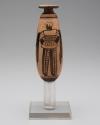Alabastron (Oil Container) with Ethiopian Warrior
Alabastron (Oil Container) with Ethiopian Warrior
Place of OriginGreece, Athens
Date480-470 BCE
DimensionsH: 5 21/32 in. (14.4 cm); Diam (rim): 1 3/8 in. (3.5 cm); Max Diam (body): 1 7/8 in. (4.75 cm)
MediumWheel-thrown, slip-decorated earthenware
ClassificationCeramics
Credit LineGift of Patricia Neils Boulter in memory of Cedric G. Boulter
Object number
1991.107
Not on View
DescriptionThis alabastron, a vessel for perfume or scented oil, derives its shape from Egyptian prototypes but was made in Athens. Its slender body fits neatly in the hand, with a narrow neck, flat rim, and rounded base requiring support when set down. It exemplifies the Attic white-ground technique: a white slip covers the body, providing a canvas for brown-black painted decoration.
The main scene shows a warrior identified as an “Ethiopian,” his head in profile, body frontally posed, and face painted black. He carries a battle axe and bow and wears patterned trousers, a meander-decorated cuirass, and a black cloak. A stool and quiver appear on the reverse. The neck and base are painted black, framing the scene.
Label TextThis elegant perfume vessel, made in Athens around 480–460 B.C., belongs to a group known as the “Negro Alabastra.” Its shape, with a slender body and flat disk rim, was adapted from Egyptian models and used mainly by women to hold scented oils. Painted in fine outline over a creamy white surface, the main scene shows an African warrior in a striking frontal pose. He holds a battle axe and bow and wears patterned trousers, a decorated breastplate, and a dark cloak draped over his arms. The reverse shows a simple stool and a hanging quiver. Scholars link this vessel to a workshop known for decorating alabastra with figures of foreign warriors and Amazons. Once associated with the legendary allies of Troy, these figures came to embody the Greek fascination with distant peoples and the allure of the exotic.
Note on Terminology : The phrase “Group of the Negro Alabastra” comes from early twentieth-century scholarship and refers to a small set of Attic perfume vessels decorated with dark-skinned warrior figures. The term, now considered outdated and offensive, is retained only as a historical label for this group’s scholarly identification. The warriors are conventionally described in Greek sources as “Aithiopians” (Ethiopians) and should be understood as part of a broader repertoire of “foreign” or “exotic” figures—such as Amazons—rather than as portraits of specific individuals. In this context, “Ethiopian warrior” is the preferred modern description, emphasizing the cultural and artistic imagination of difference in classical Athens rather than modern concepts of race.
Published ReferencesMünzen und Medaillen A.G., Auktion 16, Basel, 1956, pl. 27, no. 114.Beazley, John D., Attic Red-figure Vase Painters, Oxford, 1963, p. 268, no. 15.
Neils, Jenifer. “The Group of the Negro Alabastra: A Study in Motif Transferal.” Antike Kunst, vol. 23, 1980, p. 17, no. 23, pl. 4.5-7.
Neils, Jenifer. “The Group of the Negro Alabastra Reconsidered.” In F. Giudice and R. Panvini (Eds.), Il greco, il barbaro e la ceramica attica, vol. 4. Rome: L'Erma di Breitschneider, 2007, p. 73.
Peck, William, and Sandra Knudsen. Egypt in Toledo: Ancient Egyptian Art at the Toledo Museum of Art. Toledo: Toledo Museum of Art, 2010, p. 62.
c. 1850
250-150 BCE
The Acheloos Painter, Leagros Group
about 510-500 BCE

Membership
Become a TMA member today
Support TMA
Help support the TMA mission

















